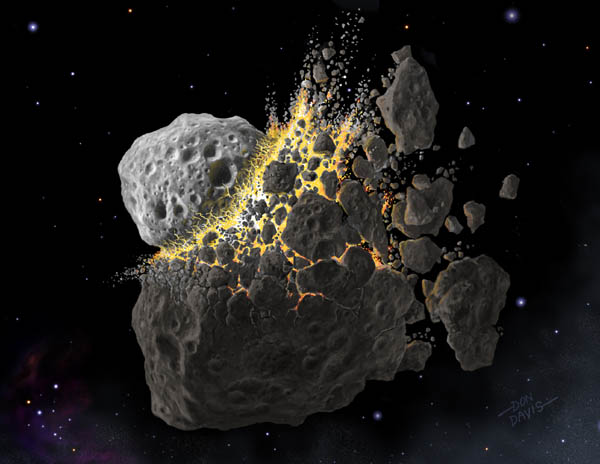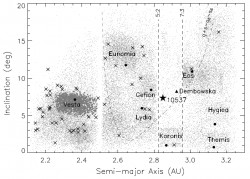Asteroid 10537 (1991 RY16) is a rarity. It is composed of basaltic rock (i.e. rock that cooled quickly after formation from a molten state) and appears to have evolved independently from the large asteroid Vesta. Vesta suffered a huge impact billions of years ago, and the debris from this collision litters the inner asteroid belt. These “Vestoids” make up the majority of the basaltic asteroids apart from three known isolated bodies including asteroid 1991 RY16. Scientists are therefore very interested to understand the evolution of 1991 RY16, possibly helping us understand the formation of the Solar System and why there aren’t more basaltic asteroids out there…
The asteroid belt occupies the volume of space roughly between the orbits of Mars and Jupiter. There are thousands of known rocky bodies in the belt, but half of the mass can be found in four major asteroids; Ceres, 4 Vesta, 2 Pallas, and 10 Hygiea. Ceres is actually classified as a minor (or dwarf-) planet as it is over 900km (560 miles) in diameter and is roughly spherical, unlike other asteroids that are irregular in shape. Large asteroid Vesta suffered a huge impact during the formation of the Solar System some 3.5 billion years ago and the debris (about 1% of its total mass) from this collision can be found scattered around the orbit of Vesta (~2.4 AU). These Vestoids usually explain many of the basaltic asteroids in this region of the asteroid belt.
So where does 1991 RY16 come in? Researchers at the Institute for Astronomy (IfA), University of Hawaii, carried out an analysis of the object after a previous study that utilized the Sloan Digital Sky Survey Moving Object Catalog. The IfA astronomers then used optical and near-infrared observations to derive spectroscopic data for 1991 RY16 to see whether it can be related to any of the asteroid groups in the asteroid belt. It turns out that its basaltic surface composition doesn’t appear to match up with any of the large groups of asteroids, and if its orbital radius is worked into the equation, it is highly unlikely that it could have travelled from any of the groups. 1991 RY16 appears to be an asteroid loner… or does it?
Firstly, the 5-15 km wide asteroid had to be ruled out from being a more common Vestoid. For a start 1991 RY16 isn’t even a remotely close spectroscopic match to any of the known Vestoids. Its orbit beyond the 3:1 Jupiter orbital resonance (at a distance of 2.5 AU) suggests that it could not have travelled from 2.4 AU, through the resonance and to its present orbit of 2.85 AU. The orbital resonances of the larger planets cause separation in the asteroid belt populations, confining them to their orbits. So, 1991 RY16 doesn’t originate from the Vesta impact event 3.5 billion years ago. Looking at the positions of the known asteroids (chart pictured), the IfA group ruled out the association of 1991 RY16 with any of the neighbouring asteroid groups (such as Gefion and Eos) as there is little spectroscopic evidence and it isn’t possible that the asteroid simply drifted (even after considering the strange Yarkovsky effect that predicts small rocky bodies experience a small deflection in trajectory due to anisotropic emission of thermal photons).
The possible remaining explanation could lie with a large asteroid near the orbital vicinity of 1991 RY16. The spectroscopic analysis of 1991 RY16 reveals that it could be a large chunk from another, differentiated asteroid. Although more analysis is required, 349 Dembowska (of ~140km in diameter) could be the parent asteroid 1991 RY16 was chipped from during an impact in the young Solar System. The IfA researchers are keen to point out that more observations are required to see if there is any other debris from this possible collision matching the surface composition of 1991 RY16.
For more detail into this very interesting research, check out the paper below.
Source: “A Spectroscopically Unique Main Belt Asteroid: 10537 (1991 RY16)” (arXiv pdf)


